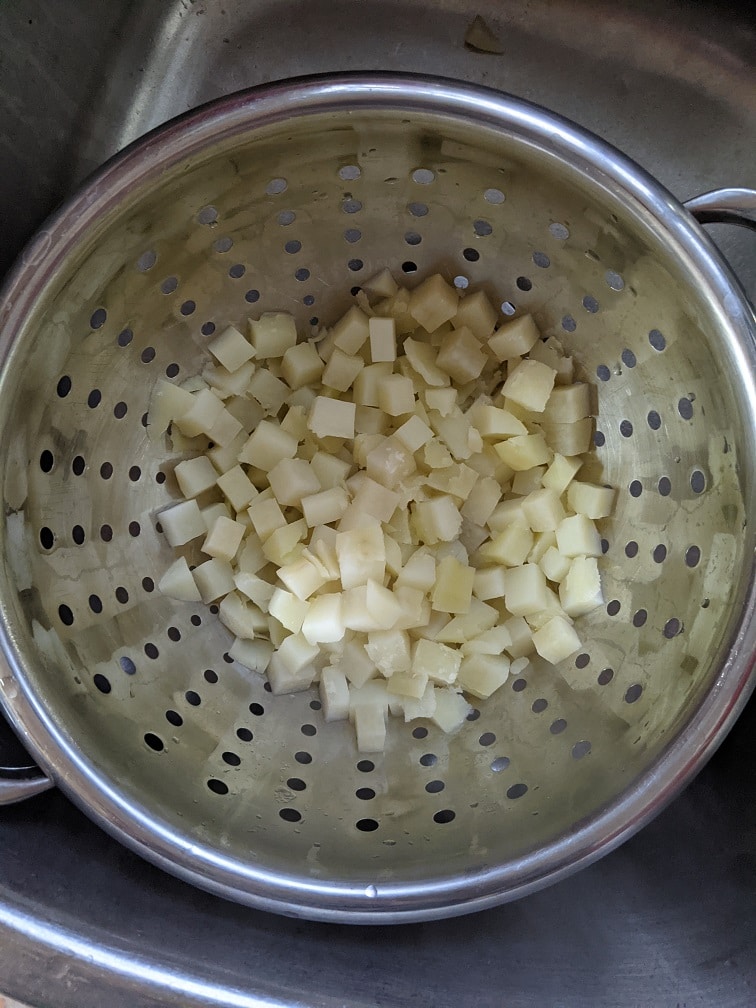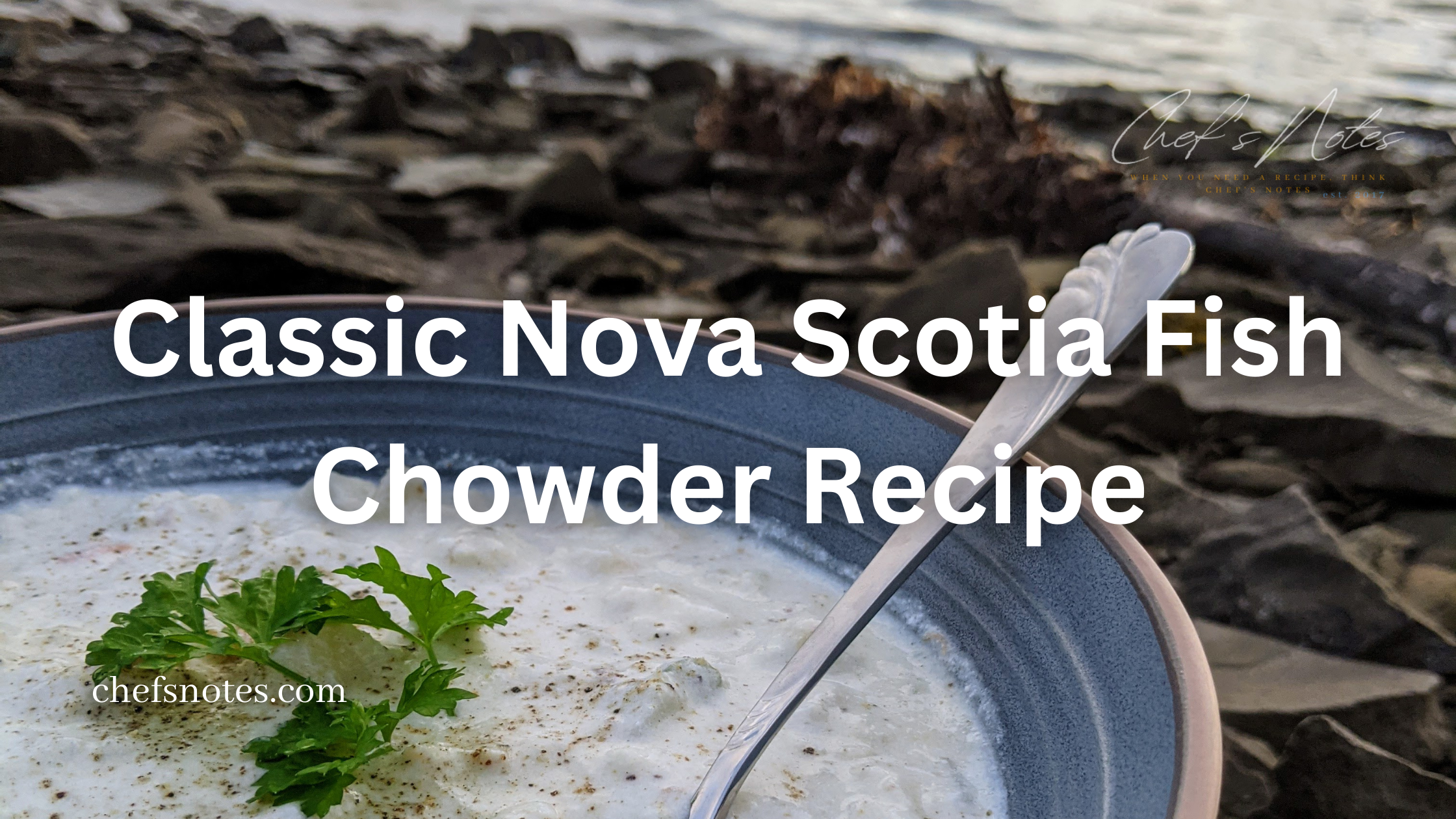Nova Scotia Fish Chowder holds a special place in my heart because of a childhood memory that has stayed with me for nearly two decades. When I was younger, my father would take my sisters and I to his work Christmas party, and the one thing that stood out to me the most about those events was the giant pot of chowder that was served in little cardboard cups. Even though I haven’t had the chance to attend one of those parties in many years, the taste of that chowder is still fresh in my mind.
Inspired by that memorable experience, I decided to recreate the recipe and share it in this post. Nova Scotia seafood chowder is known for its hearty, filling qualities, and this recipe is no exception. It is creamy, thick, and packed with a variety of fish, just as a true Nova Scotia fish chowder should be. This is not a delicate or refined soup – it is a hearty, satisfying meal that will warm you from the inside out on a cold, blustery day. So if you’re looking for a comforting, satisfying chowder that will stick to your bones and chase away the chill, this recipe is for you.

Where’s the lobster?
One thing you might notice about this chowder recipe is that it does not contain lobster or shrimp. There are a few reasons for this. Firstly, while this chowder does include scallops, it is primarily a fish chowder and not a seafood chowder. Secondly, the chowder that I am recreating in this post did not originally contain lobster or shrimp, so I wanted to stay true to that recipe. Finally, and most importantly, I have a severe allergy to shrimp, lobster, and crab, so for my own safety and well-being, I have chosen to omit these ingredients from the recipe. That being said, if you do not have a lobster allergy and would like to add some lobster or shrimp to the chowder, you are welcome to do so. Simply omit the scallops and add in your preferred seafood to taste.
Potatoes
Potatoes are a key ingredient in any good chowder, and this recipe is no exception. I used russet potatoes, approximately two cups of peeled and diced (one to two-centimetre cubes) potato. While I typically prefer to use Yukon gold potatoes in soups and chowders because they hold their texture better, I happened to have a large bag of russets on hand, so that’s what I used. To prepare the potatoes, simply peel, wash, and dice them, then bring them to a boil in a pot of salted water. Cook the potatoes until they are tender, then drain them and set them aside. There is no need to rinse the potatoes in cold water to cool them down – they will be fine as they are.




Vegetables
This Nova Scotia Fish Chowder Recipe follows the traditional French technique of using onions, carrots, and celery as the base vegetables. I used a total of one cup of diced yellow onion, and half a cup each of diced carrot and celery. It is important to dice the vegetables into small, even pieces, ideally about one centimetre in size. This helps to ensure that the vegetables cook evenly and contribute to the overall texture of the chowder. By using a combination of these three classic vegetables, you can create a flavorful foundation for the chowder that complements the fish and other ingredients.



Fish
For this Nova Scotia Fish chowder, I used a variety of fish, including halibut, haddock, scallops, and smoked mackerel. I used approximately one pound of each of these fish, except for the smoked mackerel, which was about a half cup (possibly a little more) after it was deboned and torn into small pieces. To prepare the fish, cut it into small, two-centimetre cubes. If you are unable to find these specific types of fish in your area, there are several alternatives that you can use. For example, cod, pollock, or hake would all work well in this chowder. You could also use a combination of different types of fish to add more depth of flavour. If you are unable to find scallops, you could try using clams, mussels, or even crumbled seafood sausage. The key is to choose fresh, high-quality ingredients and cut them into small, evenly-sized pieces for the best results.







Making The Chowder
To begin making the chowder, start by heating a large pot over medium heat. Add one tablespoon of canola oil to the pot, followed by the diced vegetables and two tablespoons of butter. Cook the vegetables until they are tender and the onions are translucent, which should take about five minutes. Once the vegetables are cooked, add a half teaspoon of poultry seasoning blend, a half teaspoon of salt, an eighth teaspoon of black pepper, and two tablespoons of flour (I used gluten-free all-purpose flour, but you can use regular flour if desired). Stir the ingredients together and cook for an additional two minutes. This will help to create a flavorful base for the chowder and thicken the broth slightly.



Dairy
Nova Scotia fish chowder is typically made with a combination of cream and milk, which helps to create a rich, creamy texture. For this recipe, I used a total of five cups of whole milk and two cups of whipping cream. It’s important to add the cream to the pot first, followed by the milk. This is because the milk may curdle if it is added to the hot pot before the cream. Once both the cream and milk have been added to the pot, gently simmer the mixture, stirring occasionally to ensure that the roux does not stick to the bottom of the pot. Cook the dairy for about ten minutes, or until the raw flour flavor has been cooked out. This will help to create a smooth, velvety base for the chowder.


Building the Fish Chowder
Now that you have prepared the vegetables, roux, and dairy base for the chowder, it’s time to start building the rest of the dish. Begin by adding the cooked potatoes, smoked mackerel, and scallops back into the pot. Let the pot heat back up for four minutes, then add the halibut and haddock. Stir the ingredients together and simmer the chowder for ten minutes. This will give the fish and scallops time to cook through and absorb the flavors of the chowder. As the chowder simmers, the broth will thicken and the seafood will become tender, creating a rich, hearty meal.



Finishing The Chowder
Once the chowder has finished cooking and all of the ingredients are well combined, it’s time to taste and season the dish to your liking. Take a spoonful of the chowder and taste it, then adjust the seasoning as needed with additional salt and pepper. You may find that the chowder needs a little extra salt to bring out the flavours, or you may prefer a more heavily-peppered chowder. Experiment with different amounts of salt and pepper until you find the combination that tastes best to you.
When the chowder is seasoned to your liking, it’s time to serve it. Ladle the chowder into bowls and serve it with butter biscuits, crackers, or rolls on the side. You can also top the chowder with a sprinkle of fresh herbs or a drizzle of olive oil for added flavour and visual appeal. Enjoy your delicious, hearty Nova Scotia seafood chowder and savour the comforting, warming flavours of this classic dish.


Ingredients
- 1 tbsp canola oil
- 2 cups diced potatoes
- 1 cup diced onion
- 1/2 cup diced celery
- 1/2 cup diced carrot
- 2 tbsp butter
- 2 tbsp flour gluten-free all-purpose
- 2 cups whipping cream
- 5 cups whole milk
- 1 lb scallops, cut into quarters
- 1/2 cup smoked mackerel, shredded optional
- 1 lb halibut, diced
- 1 lb haddock, diced
- 1/2 tsp poultry seasoning spice blend
- 1/2 tsp salt
- 1/4 tsp pepper
Instructions
- Boil the diced potatoes in salted water until they are tender. Drain and set aside.
- Heat a large pot over medium heat. Add the canola oil carrots, onion, and celery and cook until the vegetables soften and the onions turn translucent.
- Add the butter, poultry seasoning, salt and pepper into the pot. Wait for the butter to melt, then add in the flour and stir until the flour has been completely moistened by the butter. Cook for two minutes or until the roux (butter and flour mixture) turns from white to blond.
- Add the whipping cream and whole milk into the pot, in that order. Heat the dairy, stirring to ensure the roux doesn't stick to the bottom. Let the dairy simmer for ten minutes.
- Add the potatoes into the pot and slowly add the fish into the pot. If you add it all at once, it will change the dairy's temperature too quickly and may cause it to split. So, add smoked mackerel and scallops first. Let those cook for three to four minutes, then add in the halibut and haddock, simmer for about ten minutes or until the seafood is cooked.
- Taste the chowder and adjust the seasoning with salt and pepper as needed. Serve with buttered biscuits, crackers, or rolls.
Notes
Conclusion
Nova Scotia Fish Chowder is a hearty, comforting dish that represents the spirit of the people who call this region home. Hardworking, resilient, and always ready to lend a helping hand to their neighbours, Nova Scotians know how to weather life’s storms with stoic determination. And what better way to do that than with a big bowl of chowder? This recipe is my own interpretation of the classic Nova Scotia fish chowder, a creamy, thick, and filling soup that is perfect for chasing away the chill of a cold, blustery day. Whether you are from Nova Scotia or simply looking for a comforting meal to warm your bones, this chowder is sure to hit the spot. So why not give it a try and let your cares, worries, and problems melt away as you savour the flavours of this classic dish? Simply make a batch of chowder, grab a buttered roll, and sit back with a big bowl of it as you imagine the cold, salty air of the North Atlantic and the seagulls cawing in the distance. That’s what this chowder is all about – a moment of peace and comfort in a world that can sometimes be a little overwhelming.



0 Comments